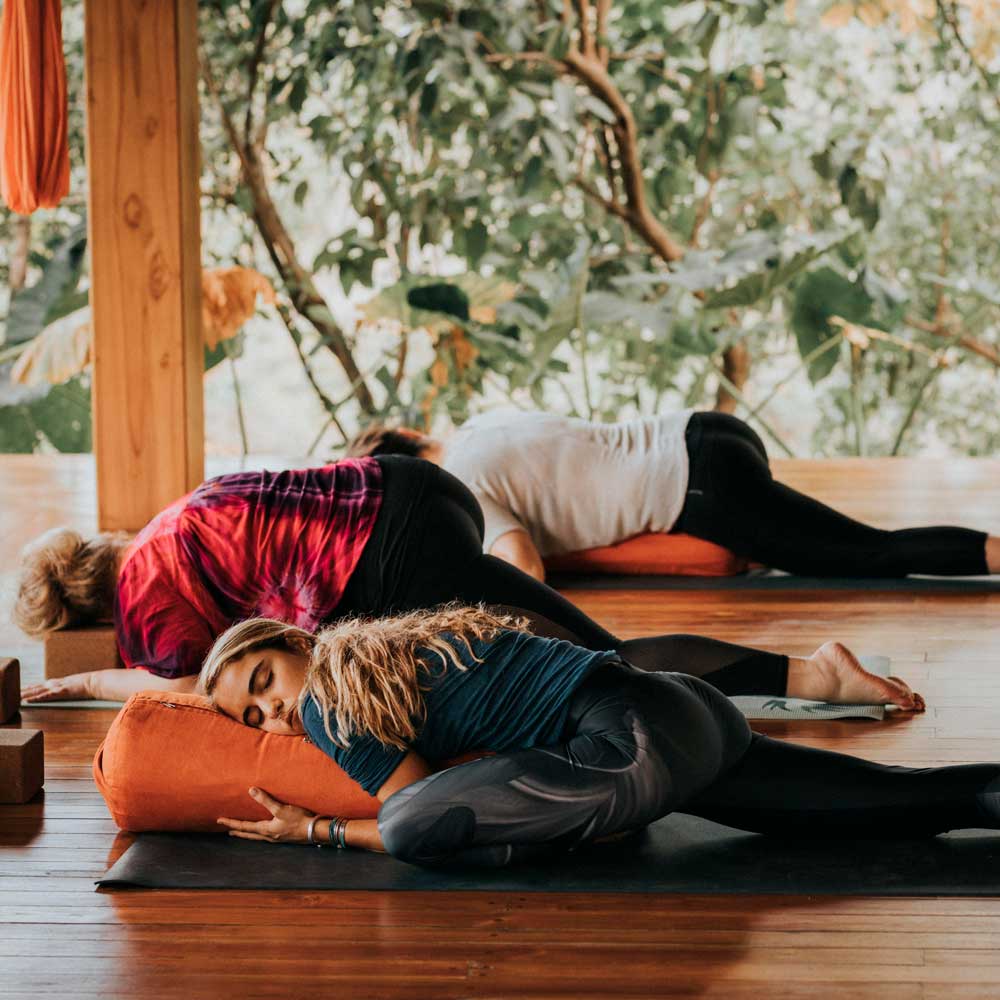Both of these types of yoga are slow-paced, and can seem very similar to students, so…
How do you tell the difference between restorative yoga and yin yoga?
I would first start by pointing out the differences between yin and yang yoga; yang yoga tends to be more fast-paced, rigorous- the “kicking-off calories” type of practice. While yin and restorative yoga are typically more of a slower-paced, deeper practice.
Many define restorative yoga to be solely for someone who is injured, and while it does work to heal an injured body, it can be incredibly beneficial for all. Restorative yoga is an older form of yoga, developed by my teacher BKS Iyengar, while yin yoga was developed in the late 70’s. I was blessed with the opportunity to learn under BKS Iyengar and TKV Desikachar. Both widely known as leaders in yoga therapy and tailoring yoga methods to meet the needs of the student- healing and restoring the body.
In my opinion, I do not see a big difference between restorative yoga and yin yoga other than the posture choices. Yin yoga utilizes more “active” poses, while restorative yoga utilizes poses that restore the body, moving deeply into the body’s tissue to activate and modify at the deepest levels. I also don’t see a big difference because it is the mind that is similar in both. In the end, this is really what all yoga is- bringing the mind to a place of stillness, which is aimed at the self, the soul, the One. This is the place where the troubles of life melt away and the essence of our souls shine forth.
Both are slow-paced, allowing the yogi to move through the poses bringing calm to the mind and body. Both restorative yoga and yin yoga are excellent; they are great options for all levels, and allow the body to slow down and bring the focus inward. When practiced correctly, they are therapeutic and healing for the yogi.
How do I benefit from restorative yoga?
After learning from Iyengar, I saw that the world needs restorative yoga now, more than ever. So many of us are living fast-paced lives, and developing ailments that are typically highly correlated with stress. When we practice restorative yoga, our bodies and minds soften, allowing space for us to connect with our innate nature and heal the ailments we may be suffering from.
One of my amazing students wrote me an email testimonial, saying,
“with the high anxiety generated in my final year of graduate school – I have learned that my emotional well being is more important than having a rock solid body. I have begun a regular, at home restorative yoga practice and I can not even put into words how much healthier I feel, emotionally, and how much more grounded and connected I have become. So for that- thank you. Thank you for teaching me what really real yoga is.”
How do I practice Restorative Yoga?
Restorative yoga is easy to implement at home. All you need is a quiet place, soft music, a rug or carpet, and a few pillows. Use this video and the list of ten yoga asanas movements below to begin your journey with restorative yoga. Hold each posture for 18 breaths to ten minutes each to gain full benefits.
Prone Head to Each Side – Be mindful of your neck relaxing and releasing tension as you position your head to each side for the same amount of time.
Supported Childs Pose – This is a very yummy pose with props, allow your head to rest on each side for the same amount of time.
Supported Sitting Forward Fold – An excellent posture for anyone, make sure you have enough props to fully support your torso so you can release your lower back.
Supported Pigeon – This posture can bring awareness to just how tight your hip area is, so make sure you prop yourself wisely.
Supported Bridge – An excellent posture to release your lower back.
Legs Up The Wall – A favorite of everyone, extremely relaxing, sleep inducing, especially with the use of props.
Reclining Bound Angle – While this is a relaxing posture for 80%, the 20% with very tight hips will need prop under each leg to fully relax and gain the benefits of this body position.
Supine Spinal Twist – I begin almost every class I teach with this posture. Every body can do it, and every body needs it.
Supported Fish – A wonderful position especially for those of us who lifestyles close their front body. If you are processing grief, PTSD, etc. this will be a challenging position to be in for a long amount of time. My playlist on Spotify will help you be in this position.
Supported Side Lying Spinal Twist – this is a poster that is looked over in most yoga classes, and it is so needed by all of us! The reason, we do not stretch our side bodies in day to day life.
While practicing the above postures, keep in mind these four points.
Allow your body to surrender with gravity, mindful breathing will help, and let your body’s abilities dictate your movements – both in position into the postures, and letting go in the poses themselves.
Take deep, mindful breaths into your body. Your breath is your body’s life, and it will enhance relaxation and stability.
Be sure to include the intelligent use of props from around your house, so you find loving comfort in every pose.
It is important to sequence wisely in order to work the body properly, and allow for deep movement your body’s tissue.
Take these reminders with you on your individual journey through healing. Whether you’re focusing on healing your mind or body, give yourself grace as this is a journey not a race. Watch as your mind and body strengthen, bringing you back to your true nature of compassion and understanding towards yourself and those around you.
~XOM








